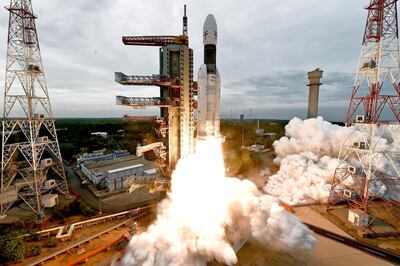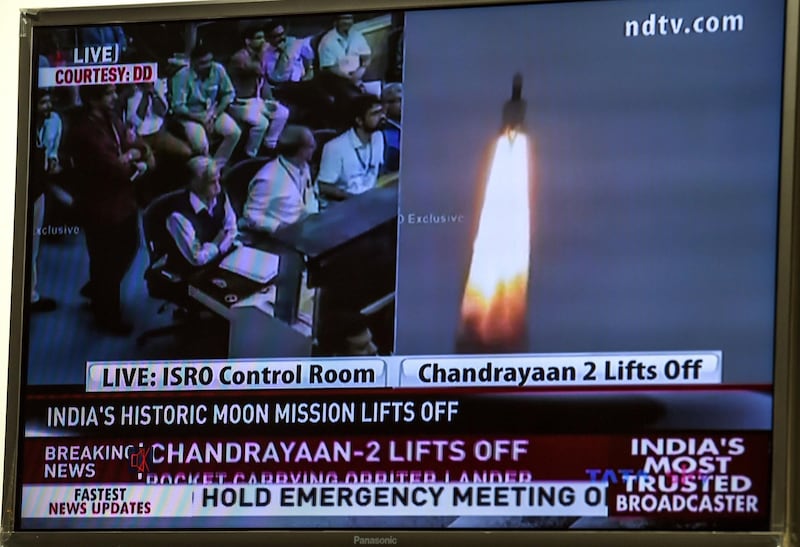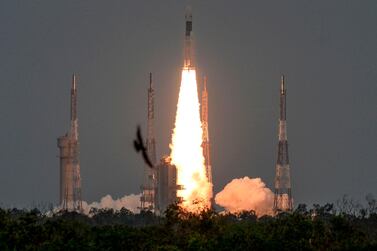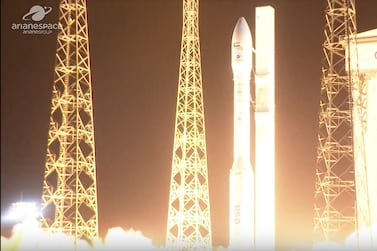India's unmanned moon mission, Chandrayaan-2, entered lunar orbit last week, a significant step in the spacecraft's journey that began when its blasted off in July.
The mission is to land on the moon's south pole in two weeks' time. If successful, India will become the first country to do so.
The ambitious Chandrayaan-2 project is seen as a giant leap forwards for India's space programme, managed by the country's space agency, the Indian Space Research Organisation (ISRO). And as India's space industry develops, it is creating more and more opportunities for the private sector, which will help boost the country's economy and job creation in the longer term, according to analysts.
“It's long due for India,” says Chaitanya Giri, the ocean and space studies programme fellow at Gateway House, a foreign policy think tank based in Mumbai. “We're expecting about 150,000 high-skilled jobs to come up in the space industry over the next five years, including jobs for engineers, scientists and data analysts.”
The potential of the space industry is enormous. The global space market is worth $350 billion (Dh1.3 trillion) and is forecast to expand to $550bn by 2025, but India's share currently only accounts for 2 per cent of this market, according to a report by the Observer Research Foundation. For India, much of its space activities are currently made up of satellite imagery, navigation and television, despite impressive capabilities, the report adds.
But an encouraging sign for the sector is that ISRO's annual budget has almost doubled to $1.45bn compared to five years ago.
Among those closely watching the progress of India's $150 million journey to the moon is SM Vaidya, the executive vice president and business head at Mumbai-based manufacturing firm Godrej & Boyce. Its aerospace division manufactured engines for the rocket used in the Chandrayaan-2 mission, along with components for the spacecraft.
“We're very excited about this mission,” says Mr Vaidya.
And India's space ambitions are only growing. The prime minister Narendra Modi is aiming for the country to launch its first manned mission by 2022. Plans for India to set up its own space station were also announced this year.
As its activity increases, Mr Vaidya says that ISRO is planning to hand over more of its manufacturing work to the private sector. This is progressing and the manufacturing of some rockets is expected to be privatised, he says. “Then here will be a huge potential for us to export our capabilities in a much bigger way”, he explains, which would lead to a surge in business. In anticipation of this, Mr Vaidya says that Godrej has secured an area of land outside of Mumbai to expand its facilities.
“We hope to set up state-of-the-art facilities which are five to six times bigger than what we are operating today and that will be dedicated for the Indian space programme and the Indian defence programme,” he says.

Chandrayaan-2 is India's second moon mission. The first moon mission Chandrayaan-1 was launched in 2008. It orbited the moon but did not land on the lunar surface. Although that mission was eventually cut short because of technical glitches, it was still widely considered a success, playing a role in the discovery of water on the moon. Chandrayaan-2's target is to explore the lunar surface to study water and minerals, with one of its aims being to better understand the origins of the moon.
In 2014, India launched its Mars mission. At a cost of $74m, Mr Modi has noted that the project cost less than the making of the Hollywood movie Gravity.
India has rapidly developed a reputation globally for being able to deliver relatively low-cost space projects.
Satellite launches have become more frequent for India, with ISRO already entered into some commercial arrangements with many other countries, including the US and the UK, to launch their satellites.
“India has emerged as a major space power with the technology and ability to launch satellites and other space products at globally low cost,” said Nirmala Sitharaman, India's finance minister, in her union budget speech last month. “The time has come to harness this ability commercially.”
To this end, Ms Sitharaman highlighted that a public sector enterprise, New Space India Limited, “had been incorporated as a new commercial arm of the department of space to tap the benefits of the research and development carried out by ISRO”.
She added that “the company will spearhead commercialisation of various space products including production of launch vehicles, transfer to technologies and marketing of space products”.
SS Mantha, a robotics, artificial intelligence, and space consultant based in Mumbai, says that this is part of “the government’s plan to make space a major industry”.
“One of the most important efforts of the country’s space programme is the commercial aspect,” he says.
A criticism that often surfaces when India invests in space projects such as the latest moon mission or its plans to send an astronaut into space, is whether the country should be spending so much money on space when it has problems on the ground to tackle including widespread poverty and poor infrastructure.
But analysts point out that developing the space industry brings enormous benefits.
Space technology, for example, can have a huge range of applications, from helping farmers track weather patterns, to uses in broadcasting and disaster management, Mr Giri says.
The job creation aspect is also important as India grapples with high unemployment levels, which hit a 45-year-high of 6.1 per cent in the year to June 2018 and with a million people entering the workforce every month, according to official figures.
Compared to some other countries, however, where there are private companies like Elon Musk's SpaceX and Jeff Bezos’ Blue Origin in the US and Richard Branson's British spaceflight company Virgin Galactic, India is definitely “lagging”, says Mr Giri.
He says there's enormous scope for more public-private partnership and for private companies to find currently untapped opportunities in the sector.
“The priority should be that India becomes on par with if not the Americans, but the Chinese, the French, the Russians,” he adds.
One of India's main advantages over its competitors is its ability deliver work at a lower cost.
“As the sector expands, remaining competitive is important,” says Mr Mantha. “Obviously, China and other foreign players are the competitors in a very competitive market. The small satellites market probably will lead in India with advantages it offers on the cost to manufacture and launch.” But he warns that “being cost effective may not be enough.”
He points to competition from major private players globally all the way to Chinese start-ups.
But Indian companies that are already benefiting from the sector's growth remain hopeful. Wipro 3D, based in a Bangalore, is another manufacturer in India that is supplying parts to ISRO. It is a metal additive manufacturing solutions firm that has developed 3D-printed components for ISRO satellites.
“Countries with mature and nascent space programmes alike are recognising India, its space scientists and the rapidly growing Indian space ecosystem as a force to reckon with,” says Ajay Parikh, the vice president and business head of Wipro 3D.
Businesses like this are now eagerly looking ahead to Chandrayaan-2's landing on the moon, expected on September 7. That will be by far the most challenging part of the mission, ISRO warned. But if successful, India's space industry will be cleared for blast off.








